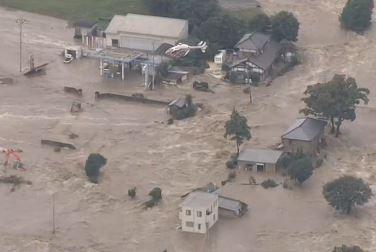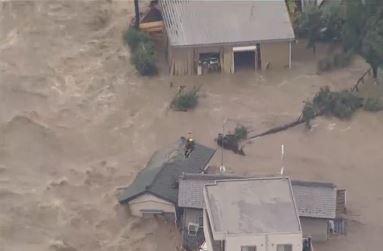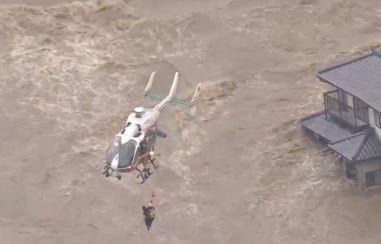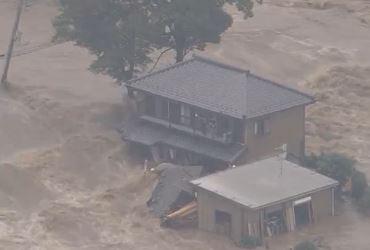Published: September 10,2015
Japanese officials issued a third emergency weather warning Friday morning as torrential rains associated with former Tropical Storm Etau shifted north after dumping unprecedented rainfall on parts of eastern Japan Wednesday and Thursday. The number of missing has climbed to 25, and one person has been killed and 27 others injured due to the storm, which has flooded thousands of buildings, caused at least 60 landslides, and left several thousand people stranded.
Dramatic helicopter rescues unfolded on live television in Japan on Thursday as a flood-swollen river breached a levee, sending raging floodwaters into a neighborhood north of Tokyo and leaving dozens of residents trapped on the roofs or upper floors of their homes.
 Water
from the Kinugawa River (left) rushes through a levee break into the
city of Joso, Ibaraki Prefecture, on Thursday, Sept. 10, 2015. (Jiji
Press/AFP/Getty Images)
Water
from the Kinugawa River (left) rushes through a levee break into the
city of Joso, Ibaraki Prefecture, on Thursday, Sept. 10, 2015. (Jiji
Press/AFP/Getty Images)Here's the latest from Japan:
- The number of missing rose from 12 to 25 Friday morning in Joso city, Ibaraki Prefecture, where the Kinugawa River breached a levee Thursday and flooded a large area of the city.
- About 880 people are still awaiting rescue from flooded areas near the levee break.
- A new emergency heavy rainfall warning was issued early Friday (Japan time) for Miyagi Prefecture in northern Japan, including the major city of Sendai.
- A Japanese television network's helicopter relayed images of widespread flooding in Taiwa, a town of 27,000 residents in Miyagi Prefecture, Friday morning.
- The Shibui River broke through a levee in Ōsaki city, Miyagi Prefecture, on Friday morning. At least 1,000 people were stranded in floodwaters, according to the newspaper Asahi Shimbun.
- More than 85,000 people were under evacuation orders Friday morning, and another 700,000 people have been advised to voluntarily evacuate to safer locations due to concerns about flooding and landslides.
- Parts of Miyagi and Fukushima prefectures reported 4 to 6 inches of new rainfall in 3 hours early Friday, setting all-time 3-hour rainfall records in a few locations.
- The Japan Meteorological Agency has issued the maximum "Level 5" flood warning for the Yoshida River in Miyagi Prefecture and for the Mogamiogumi River in Yamagata Prefecture.
- More than 800 people in the mountainous town of Minamiaizu, Fukushima Prefecture, have been cut off from the outside world due to flooding and landslides on the lone highway through town.
- A 63-year-old woman is confirmed dead after a landslide struck Kanuma city, Tochigi Prefecture, early Thursday. The woman was missing for hours before being found dead Thursday evening.
- A young man is reportedly "unconscious in critical condition" after falling into a drainage pipe in Nikkō city, Tochigi Prefecture.
- The Japanese government says at least 27 people have been injured in landslides, flooding and strong winds associated with Etau.
- At least 11 dwellings have been destroyed and at least 6,500 buildings have been flooded across Japan.
- As of Friday morning, the Japanese government confirmed at least 1,384 homes had been flooded.
- Up to 26 inches of rain have fallen in eastern Japan since Sunday due to Tropical Storm Etau and its remnant low.

Right Now: Clouds and Rainfall Intensity
New pictures emerge of the worsening flood situation in eastern Japan @SkyNewsAust pic.twitter.com/tU8tt8LClY (@Amy_Greenbank)
"We can say this is an abnormal situation and there is imminent serious danger," said Takuya Deshimaru, chief forecaster at the Japan Meteorological Agency, according to the BBC.
On Thursday, JMA issued similar emergency weather warnings for 5 million people in Tochigi Prefecture and Ibaraki Prefecture, north and northeast of Tokyo, on Thursday morning. The warnings were issued as a band of heavy rainfall associated with the post-tropical remnant of Tropical Storm Etau stalled over eastern Japan, dumping up to 21 inches of rain in 24 hours near the head of the Kunigawa River, which drains south through the northern suburbs of Tokyo.
The emergency warnings in those two prefectures were lowered Friday morning.
Levee Break Unleashes Dangerous Flash Flood

Rainfall Reports
Early Thursday afternoon, the Kinugawa River breached a levee in the city of Joso, Ibaraki Prefecture. Prefectural government officials there said 25 people are missing due to the flooding and hundreds of others were still awaiting rescue Friday morning, according to public broadcaster NHK.
JMA had already issued its highest level of flood warning for the Kinugawa River Thursday morning before the breach occurred.
Japan's Self-Defense Force sent helicopters to the scene, plucking a number of people from rooftops and the top stories of homes near the stricken levee. Japanese television stations broadcast some of the dramatic scenes live as they happened during the early afternoon hours Thursday.
In one disturbing scene, two people were seen struggling to cling to the roof of what appeared to be a garage or shed as the structure began to crumble beneath them and collapse into the raging floodwaters. The television broadcast, streamed live on the website houdoukyoku.jp, quickly cut away from the images to show its in-studio anchors. The fate of the couple is not immediately clear.
The scenes played out again Friday morning, as SDF helicopters plucked more victims standing on rooftops underneath sunnier skies.
At least 7,000 homes damaged or destroyed in Ibaraki.
Tochigi Prefecture: Landslides Turn Deadly
According to the Tochigi Prefecture government, a landslide early Thursday in the city of Kanuma left one person dead and another person injured. NHK says the body of the missing person, a 63-year-old woman, was found Thursday evening. The woman was later confirmed dead.Kanuma reported 444 millimeters (17.48 inches) of rain in the 24-hour period ending at 6 a.m. local time Thursday; in records that began in 1976, this was more than double the city's previous 24-hour record of 212 mm (8.35 inches) set July 11, 2002.
The incident was one of 30 landslides reported by the prefectural government as of Thursday afternoon. One home each was damaged in two of the landslides, and 11 people were trapped but later rescued in another of the incidents. The government said five people were stranded in Nikkō due to flooding on a local river Wednesday night; firefighters rescued them around daybreak Thursday.
The rain was extraordinarily heavy in and around the city of Nikkō, a popular tourist destination in Tochigi Prefecture. JMA's observation side in that city's Imaichi district recorded 668.0 millimeters (26.30 inches) of rain Sunday through Thursday. Of that amount, 541 mm (21.30 inches) fell within a 24-hour period Wednesday and early Thursday. The nearby Ikari observation site in Nikkō city logged 551 mm (21.69 inches) of rain in the 24-hour period ending at 6:30 a.m. Thursday; that was the highest 24-hour rainfall total anywhere in Japan during the storm.
Those sites' 24-hour rainfall totals were the highest ever recorded since rainfall measurements began there in the late 1970s – and the 24-hour totals alone at both sites were greater than the previous 72-hour rainfall records for each location. The same is true of several other nearby sites – a sign of just how extreme the rainfall has been.
Hundreds of Thousands Asked to Evacuate
Evacuations became mandatory in some locales as the rain continued and rivers rose. In all, about 85,000 people in Miyagi, Fukushima, Yamagata, Tochigi and Ibaraki prefectures were under evacuation orders early Friday morning, according to the FDMA. An unspecified number of additional people in Miyagi Prefecture were also under evacuation orders, with the Nanakita River being of particular concern for flooding.Another 700,000 people were still being advised to evacuate voluntarily in several eastern and northern prefectures.
Rainfall rates exceeding 1 inch (25 mm) per hour continued early Friday in parts of Fukushima, Miyagi, and Iwate prefectures, including areas hard hit in the March 2011 earthquake and tsunami. By late morning, however, the rain band had weakened considerably.
Storm Impacts Wide Swath of Japan
Tropical Storm Etau affected many other areas of Japan prior to and during its landfall. Here's a wrap of its impacts Tuesday and Wednesday:- Tochigi Prefecture: Officials were investigating whether rainfall in advance of Etau's landfall contributed to a slope failure at a mine in Ashikaga on Tuesday afternoon. According to Tokyo television station TBS, a 20-year-old worker was buried alive and later died in the hospital.
- Fukushima Prefecture: According to the Mainichi Shimbun, a national newspaper, heavy rainfall Wednesday caused contaminated water from the crippled Fukushima Daiichi nuclear power plant site to run off into the Pacific Ocean for several hours early Wednesday. The newspaper said it was the seventh such incident this year at Fukushima Daiichi, which suffered a catastrophic meltdown after the 2011 Tohoku earthquake and tsunami.
- Kanagawa Prefecture: More than 600,000 people in the city of Kawasaki were advised to evacuate during the height of the heavy rainfall, according to government reports. Nearby, the city of Yokohoma recorded a five-day rainfall total of 306.5 millimeters (12.07 inches).
- Shizuoka Prefecture:
- Flash floods and landslides were reported Tuesday in the city of Hamamatsu, according to NHK. Sediment from one of the landslides overturned a car, slightly injuring a man in his 40s, NHK said. In addition, two people were slightly injured after falling in flooded roadways in the city.
- At least 49 locations in Hamamatsu reported road flooding, along with 35 in the neighboring city of Iwata.
- NHK also said a section of cliff 10 meters (33 feet) high and 10 meters wide crumbled behind houses in a Hamamatsu neighborhood. No injuries were reported. Hamamatsu reported 388.5 millimeters (15.30 inches) of rainfall in the 72-hour period ending at 9:20 a.m. Japan time Wednesday, according to JMA data.
- NHK said there were at least 11 landslides in Shizuoka Prefecture alone.
- The top rainfall total near Etau's landfall zone was 424.5 mm (16.71 inches) on Mount Amagi in Shizuoka Prefecture in the 72-hour period ending at 4:20 p.m. local time Wednesday.
- Two elderly men suffered minor injuries after falling in strong winds as Etau made landfall west of the prefecture.
- Aichi Prefecture:
- NHK said an elderly woman suffered a serious leg injury after falling during strong winds in the city of Toyobashi on Wednesday morning.
- NHK said at least 27 flights were canceled in and out of Chubu Centrair Airport near Nagoya due to the tropical storm. Winds at Centrair gusted as high as 64 mph late Wednesday morning local time.
- Mie Prefecture: Heavy rainfall caused at least one landslide in the city of Toba, which was also buffeted by strong winds as the center of Tropical Storm Etau passed just east of the prefecture Wednesday.

Rainfall Forecast
Forecast: Remnant Rainfall Weakening
The rainfall from Tropical Storm Etau's remnants has finally begun to weaken.However, a separate area of rain has begun to move into parts of Hokkaido, Japan's northernmost major island, as Tropical Storm Kilo moves north toward the eastern end of that island.
Besides the emergency warnings, a number of other prefectures remain under warnings issued by JMA for heavy rainfall and landslides.
History of Tropical Storm Etau
Etau formed early Monday (Japan time) about 1,000 miles due south of Tokyo. It has been moving in a generally northward direction ever since. At 10:22 a.m. Japan time Wednesday (9:22 p.m. U.S. EDT Tuesday), the Japan Meteorological Agency announced that the center of Tropical Storm Etau had made landfall on the Chita Peninsula of Aichi Prefecture shortly after 10 a.m. local time. The landfall point was about 30 miles (50 kilometers) south of Nagoya, the center of Japan's third-largest metropolitan area.Later Wednesday, the center emerged into the Sea of Japan. JMA said Etau became a post-tropical low-pressure center at 9 p.m. Japan time Wednesday.
As of late Wednesday evening, the top reported sustained wind on land was 22.8 meters per second (51.0 mph) at 9:47 p.m. local time at Cape Erimo on Japan's northernmost major island, Hokkaido. The top gust was 30.9 m/s (69.1 mph) at 5:03 a.m. local time Wednesday on the small island of Kozushima, about 100 miles south of Tokyo.
Tropical Storm Etau was known as "Typhoon No. 18" in Japan, where tropical cyclones are typically referred to by number rather than name, and "typhoon" is used for all systems of tropical-storm or higher strength.
The name "Etau" was also given to a tropical storm that drenched Japan in 2009, killing 28 people and flooding thousands of homes.
Stay with The Weather Channel and weather.com for the latest on this dangerous weather situation unfolding in Japan.
MORE: Tropical Storm Etau Strikes Japan (PHOTOS)







No comments:
Post a Comment